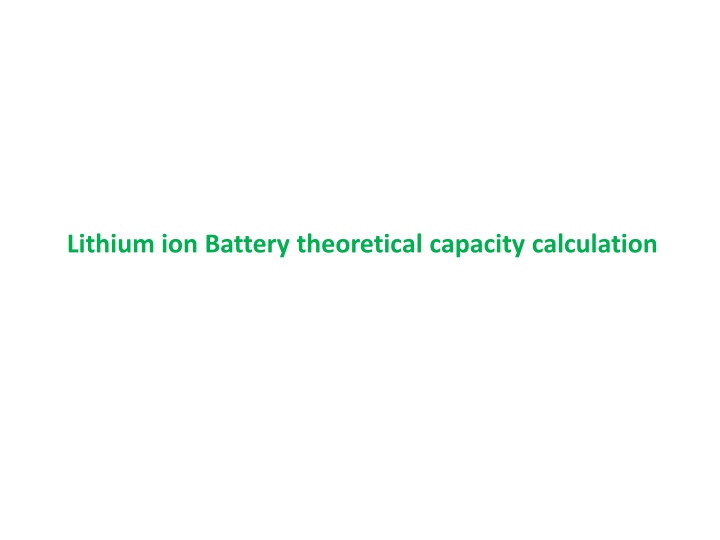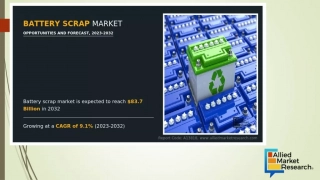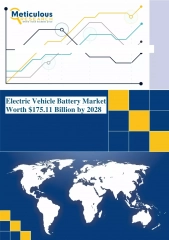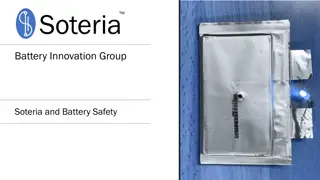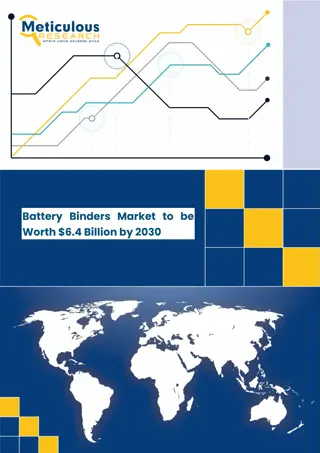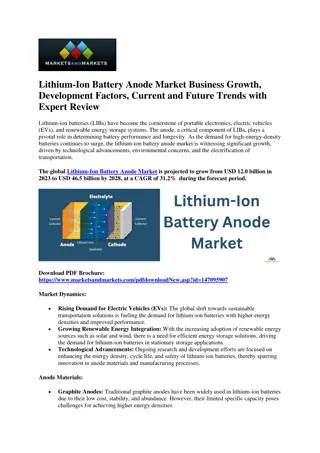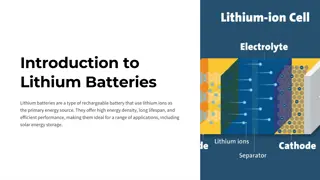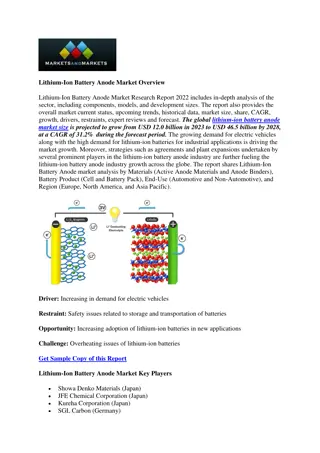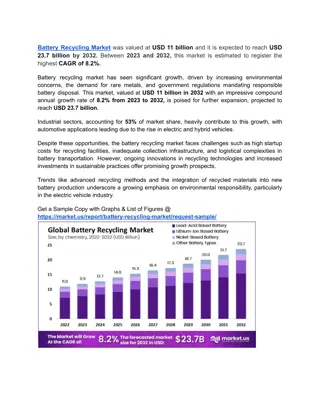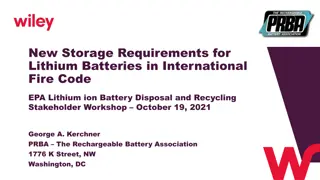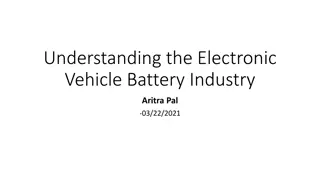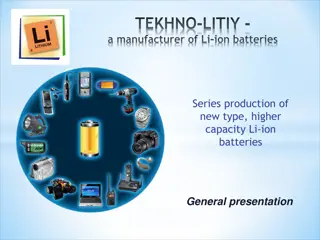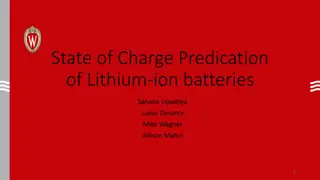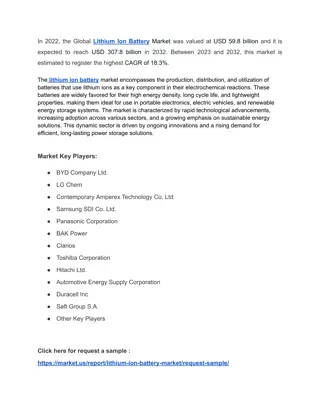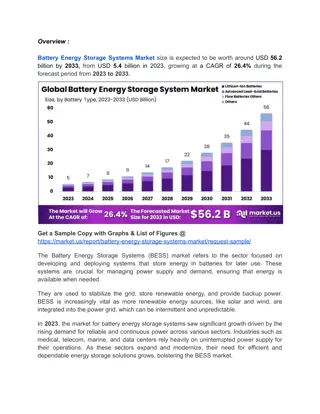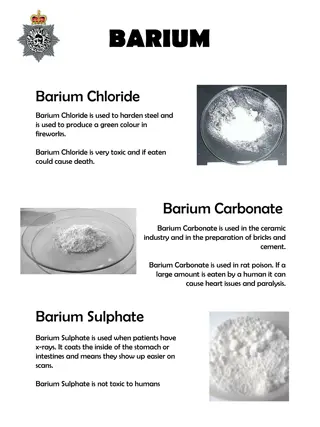Calculating Theoretical Capacity of Lithium-Ion Battery
The theoretical capacity of a lithium-ion battery can be calculated based on Faraday's laws of electrochemistry, considering the transfer of electrons and ions. Understanding the electrochemical processes and energy transfer helps determine the capacity of different battery systems and materials like LiMn2O4 and Li2Mn2O4. Chemical potentials and energy changes in the battery system are essential in optimizing performance.
Download Presentation

Please find below an Image/Link to download the presentation.
The content on the website is provided AS IS for your information and personal use only. It may not be sold, licensed, or shared on other websites without obtaining consent from the author.If you encounter any issues during the download, it is possible that the publisher has removed the file from their server.
You are allowed to download the files provided on this website for personal or commercial use, subject to the condition that they are used lawfully. All files are the property of their respective owners.
The content on the website is provided AS IS for your information and personal use only. It may not be sold, licensed, or shared on other websites without obtaining consent from the author.
E N D
Presentation Transcript
ELECTRON, ION AND COULOMBIC ENERGY The Motion of an ion in the electrolyte or of an electron in a wire is a transfer of definite amount of electricity. The actual amount of electricity transported by a single electron or a monovalent ion is very small.. 1.60186 x 10-19 Coulombs According to Faraday s law, 1 gram equivalent of any substance is equal to 96500 Coulombs, I.e., if the ion is monovalent the total charge is 96500 Coulombs and if bivalent the charge is twice of this amount.
ELECTRON, ION AND COULOMBIC ENERGY 1 Amp : 1 Coulomb / Sec 1 Amp-Sec. : 1 Coulomb 1 Amp. Hr. : 3600 Coulomb 1 Faraday : 96490 Coulombs 96490/3600 = 26.8 Ah i.e. for 1 electron transfer the coulombic energy is 26.8 Ah
ELECTRON, ION AND COULOMBIC ENERGY Lead acid Li-ion For Lead Acid Battery System For Li-ion Battery System No. of electrons transfer :2 No. of electrons transfer :1 Pos. PbO2 Molecular Wt : 239 g For a 1e- transfer, Coulombic energy is Neg. Pb Molecular Wt. :207 g 26.8 Ah For a 2e- transfer, Coulombic energy is 2 x 26.8 : 53.6 Ah
ELECTRON, ION AND COULOMBIC ENERGY Pb acid: Li-ion: Pos. active material (PbO2) required to deliver 1 ampere hour (239/53.6) : 4.46g Pos. active material ( LiFePO4) required to deliver 1 ampere hour (157.75/26.8) :5.886g/Ah Neg. active material (Pb) required to deliver 1 ampere hour (207/53.6) :3.862 g Neg. active material (C6) required to deliver 1 ampere hour (72.060/26.8) :2.689 g Li:6.941,Fe:55.845,P:30.974,O:63.998 Electrolyte (H2SO4): 3.68 g/Ah
The theoretical capacity of a material can easily be calculated from Faraday s 1st law of electrochemistry which states that 1 gram equivalent weight of a material will deliver96487 coulombs (or 26.8 Ah). For LiMn2O4 the equivalent weight (M) is 180.8 g/mol, giving a theoretical capacity of: 26.8/180.8 = 148 mAh/g Inthe same way, the theoretical capacity of Li2Mn2O4 can be determined to 285 mAh/g, ifthe whole charge/discharge range is exploited
The thermodynamic quantity describing the change in energy as a function of changes in Li concentration in the host matrix is the chemical potential ( ), defined as = G x where G is the Gibbs free energy and x is the number of inserted Li atoms. The change in free energy can also be expressed as where n is the number of electrons in both electrode-reactions in the cell-reaction above), F is Faraday s constant, and E is the potential difference between the electrodes. By combining (1) and (2), we get the relation between electrical and chemical energy in the system: G = -nFE = - FE - FE= c -- a where cc and a are the chemical potentials of the lithium ions in the cathode and anode, respectively.
Ampere-hour (Ah) capacity is the total charge that can be discharged from a fully charged battery under specified conditions. People also use Wh (or kWh) capacity to represent a battery capacity. The rated Wh capacity is defined as Rated Wh Capacity = Rated Ah Capacity Rated Battery Voltage: Power : energy by second ,watt W=A V=Current Voltage Energy :power multiplied by time WH=Ah V=Capacity Voltage Capacity : Current time Ah
Cathode material Discharge Voltage V vs .Li0 Theoretical capacity (mAhg-1) True density (g cm-3) Diffusivity (cm2s-1) LiMnPO4 4.1 171 3.43 10-7 LiFePO4 3.4 170 3.60 10-8 LiCoPO4 4.8 167 3.70 10-9 LiNiPO4 5.1 167 3.89 10-5 Li1.07Mn1.93O4 3.9 117 4.15 ~10-10 LiAl0.05Co0.15Ni0.8O2 3.6 265 4.73 ~10-8 LiCoO2 3.6 274 5.05 ~10-8 Source Theoretical evaluation of high-energy lithium metal phosphate cathode materials in Li-ion batteries JPS -165(2007)887-891
Other Cathode Materials 1. Ohzuku, T.; Brodd, R. J., J.Power Sources 2007, 174, (2), 449-456; 2. Amatucci, G. G.; Pereira, N., J. Fluorine Chemistry 2007, 128, (4), 243-262; 3. Howard, W. F.; Spotnitz, R. M., J. Power Sources 2007, 165, (2), 887-891. 37
